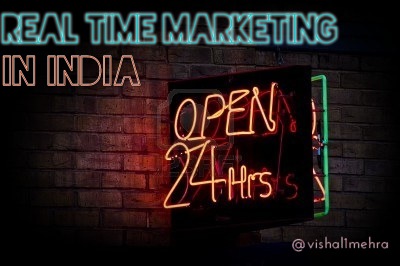
Few weeks back when I wrote about the Top Digital Marketing Trends for India on my blog, RTM (Real Time Marketing) did not figure anywhere in the list. But than February 3rd, also known as Super Bowl Blackout day happened & the world of marketing promised not to be the same ever again.
I started thinking about RTM scenarios for the Indian market & how our marketers could take advantage of those opportunities. Few related sessions in ad:tech new delhi 2013 made me think harder.
RTM is not a new phenomena which spawned one fine evening when Oreo & it’s agency partner decided to dunk in the dark, & in the process became a lifelong case study for this marketing genre. Instead Real Time Marketing techniques trace their roots back to 1990s with initial deployments of CRM solutions in major sectors, but it wasn’t so glamorous & thus not thought about much during that time.
Marketing has altered radically in the last few years, perhaps more than any other business role, and the progression will absolutely continue as marketers become more single-minded, swift and supple.
With over 150 million internet users, & 100 million social network user base, India as a market is ripe for some RTM action but this form of marketing goes far beyond simply posting a timely tweet (see Oreo/Tide during blackout), a status update or even a vine posting (see Calvin Klein). Brands have to expand the use of real time social analytics, create great content to drive engagement & make on-the-fly decisions around trending relevant topics. That certainly is hard to fathom in current Indian marketing culture.
Because Indian consumers have moved on & so must the marketing techniques employed to entertain & engage them.
But most Indian marketers still find it challenging to cut through the information clutter today to resonate. Mostly because they are not used to customers driving interactions (after all it was one way shouting till a while back) & taking control of the relationship they share.
Marketing strategies still rely heavily on arranging everything, to the T. That practice has to give way. Marketers can plan, but can’t choreograph consumer behavior.
With the sixth edition of Indian Premier League (Cricket’s top domestic club competition, akin to EPL or NFL) starting in April, Indian brands have a grand stage to get daring with their consumers & in the process get embraced.
The biggest opportunity out of all brands clearly lies with Pepsi. Pepsi is not just the official presenting sponsor for IPL 6; it is a youth driven brand urging its TA to “Live for Now”. In India its latest brand tagline “Oh Yes, Abhi” conveys the same spirit of Now, Instant & Dynamism to the impatient Indian youth.
Although my views about Pepsi not introducing the new logo in the Indian market even after 4+ years is widely known on twitter, I still believe being a challenger cola brand a new approach can have a positive impact for them.
That new approach is not just premiering new TVCs on YouTube, because that is passé, it is not just dumb tweets asking who your favorite cricketer is, it is making custom content for its online consumers which needs to be fun & useful.
And if some of that can be made at twitter speed, it would be Quaker oats on the milk (let me know if you have a better suggestion for this?)
Real Time Marketing is clearly not cut out for every brand, nor it can be done without extensive resources on a continuous basis. Probably the easiest way to implement it would be to start using it in select functions & not across the marketing department off the bat.
In today’s aggressive and rapidly fluid economy, brands are determined to remain at the vanguard of their industries, which gives Real time marketing its spotlight. In return, Brands can also expect benefits like increased WOM (Word of Mouth), Media Receptivity, Social Media Presence and Consumer consideration.
“Don’t wait to be perfect, just start”
Originally posted on my blog as a detailed post




